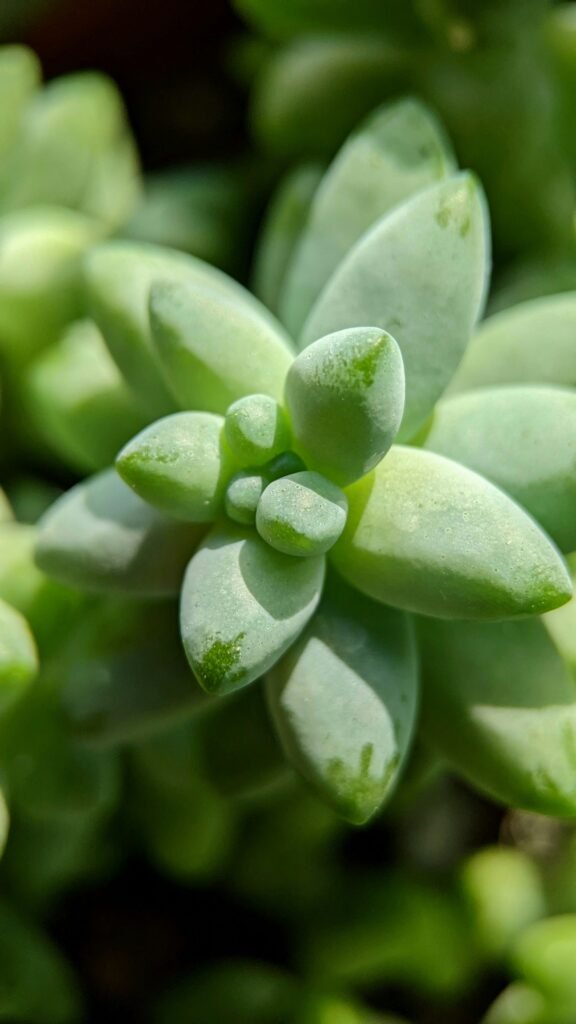

The Burro’s Tail, scientifically known as Sedum morganianum, is a delightful succulent known for its trailing stems adorned with plump, blue-green leaves.
This charming plant belongs to the Sedum genus and is native to Mexico and Honduras, where it grows as an epiphyte or trailing ground cover in rocky, arid environments.
With its unique appearance and low-maintenance nature, the Burro’s Tail has become a popular choice among succulent enthusiasts and indoor plant lovers alike.
From my personal experience, although it is part of the hardy Sedum family, it can be a tricky plant due to its fragile leaves which are prone to drop off easily. If these leave do drop off, remember that each of these single little leaves can grow into a new plant. I tend to gather them up and place them on the soil around the plant. These will eventually root and start a brand new plant, ultimately giving your Burro’s Tail a much fuller look in the pot.

Description of Burro’s Tail
The Burro’s Tail is characterized by its long, trailing stems that can reach lengths of up to 2-3 feet, adorned with clusters of small, fleshy leaves. Leaves are typically blue-green in color and have a plump, cylindrical shape, resembling the tail of a donkey or burro, hence the common name.
In optimal growing conditions, the stems of the Burro’s Tail can become densely packed with leaves, creating a lush and cascading appearance.
Growing Conditions
Sunlight: Burro’s Tail thrives in bright, indirect light but can tolerate some direct sunlight, particularly in the morning or late afternoon. Protect from intense midday sun to prevent leaf burn.
Temperature: Prefers moderate temperatures between 65°F to 75°F (18°C to 24°C). Protect from cold drafts and temperatures below 50°F (10°C).
Soil: Well-draining soil is essential to prevent root rot. A mixture of succulent or cactus potting mix with perlite or sand provides the ideal growing medium.
Watering: Allow the soil to dry out partially between waterings, then water thoroughly, ensuring excess water drains away. Reduce watering during the dormant winter months.
Humidity: Burro’s Tail prefers moderate humidity levels but can tolerate drier indoor environments. Mist the foliage occasionally to increase humidity, particularly in dry climates or heated indoor spaces.
Winter Care
Cold Protection: Protect the Burro’s Tail from cold drafts and temperatures below 50°F (10°C) by bringing indoors during the winter months or providing supplemental heating if grown outdoors.
Storage: If growing outdoors in containers, consider bringing the plant indoors before the onset of frost to protect it from cold temperatures.
Planting
When to Plant: Burro’s Tail can be planted at any time of year, although spring and summer are ideal for establishing new plants.
How to Plant: Plant stem cuttings or established plants in well-draining soil in containers with drainage holes. Ensure the roots are covered but not buried too deeply, and water lightly after planting.
Care and Maintenance
Watering: Water thoroughly when the soil is dry to the touch, but avoid overwatering, as excessive moisture can lead to root rot. Reduce watering frequency during the dormant winter months.
Fertilizing: Apply a diluted, balanced liquid fertilizer every 4-6 weeks during the growing season to promote healthy growth and foliage.
Pruning: Trim back leggy or overgrown stems as needed to maintain the plant’s shape and encourage bushier growth. Propagate cuttings from pruned stems to propagate new plants.
Pest and Disease Control: Monitor for pests such as mealybugs and spider mites, particularly in dry indoor environments. Treat infestations promptly with insecticidal soap or neem oil.
Propagation
Propagation Methods: Burro’s Tail can be propagated easily from stem cuttings.
Propagation Tips: Take 4-6 inch stem cuttings from healthy, mature plants and allow them to callus for a few days before planting in well-draining soil. Keep the soil lightly moist until new roots develop.
Each leaf, as mentioned, will also grow into a plant. Plant a singular leaf on the top of the soil and after not too long, you will notice it will shoot little roots and eventually produce a new plant.

Flowering
Blooming Season: Burro’s Tail occasionally produces small, star-shaped flowers during the growing season, typically in late spring or early summer.
Flower Description: Flowers are small, star-shaped, and can vary in color from white to pink or red, although the plant is primarily grown for its foliage rather than its flowers.
Ornamental: The Burro’s Tail is primarily grown as an ornamental plant for its attractive foliage and trailing habit. It is well-suited to hanging baskets, containers, or as a trailing accent in mixed plantings.

Uses
Companion Plants
Beneficial Plants: Burro’s Tail pairs well with other succulents and trailing plants such as String of Pearls (Senecio rowleyanus) and String of Hearts (Ceropegia woodii), creating a visually stunning display in mixed planters or hanging baskets.
Avoided Plants: Avoid planting Burro’s Tail near plants with aggressive growth habits or high water requirements, as they may compete for resources and impede growth.
Conclusion
With its trailing stems adorned with plump, blue-green leaves, the Burro’s Tail is a delightful addition to any indoor or outdoor space, bringing charm and elegance to gardens, patios, and living areas.
Whether cascading from hanging baskets, spilling over the edges of containers, or used as a ground cover in rock gardens, the Burro’s Tail never fails to captivate with its unique beauty and easy-care nature.



